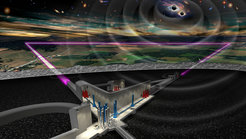Einstein Telescope task force from Belgium, Germany, and the Netherlands established
New collaboration to strengthen candidacy for the observatory in the Meuse-Rhine Euroregion
A task force from Belgium, Germany and the Netherlands will combine all current and future information from involved authorities to work on a strong, joint candidacy for the Einstein Telescope from the three countries. This task force will also map out which steps still need to be taken to submit the candidacy of the border region in a final project proposal/bidbook in 2025.
This was agreed by ministers, administrators, top officials and scientists from the three countries at a roundtable discussion on 13 December in Bonn. This marks an important step in cross-border cooperation towards a strong bidbook.
Read more on einsteintelescope.nl.

Einstein Telescope research at AEI Hannover
AEI Hannover has long been a leading institution in gravitational-wave research and is a co-initiator of the Einstein telescope. ET research at the institute focuses on quantum-limited interferometric measurements, laser development, the development of squeezed-light sources, and the control and operation of gravitational-wave detectors.
At the institute, a laser source for the Einstein Telescope Pathfinder – an observatory prototype – is being developed and tested and installed at the prototype in Maastricht. Researchers at the institute are also investigating the generation of squeezed light and the use of this technology in third generation gravitational-wave detectors, as well as the active suppression of seismic effects on the mirror suspensions of ET.
The 10-meter interferometer prototype at the institute is a test bed for new technologies that will be used in future interferometric gravitational-wave detectors such as the Einstein Telescope.
In the project “Glass Technologies for the Einstein Telescope” (GT4ET), miniaturized opto-mechanics are being developed for the Einstein Telescope in collaboration with the Fraunhofer Institute for Applied Optics and Precision Engineering.
Einstein Telescope research at AEI Potsdam
AEI Potsdam has long been playing a leading role in gravitational-wave research, and in the last few years, scientists have been involved in the development of the science case for the third-generation gravitational-wave detectors, and several of them have now joined the Einstein Telescope Scientific Collaboration. They are interested in exploiting those future detectors to extract unique astrophysical, cosmological and fundamental physics information from black holes and neutron stars. The research at the AEI Potsdam includes the i) theoretical modeling of gravitational-wave sources in vacuum and with matter through analytical and numerical techniques, ii) sophisticated and efficient data-analysis methods to infer the binary’s population properties, the internal composition of neutron stars and the nature of gravity, and iii) investigations of phenomena involving electromagnetic counterparts of gravitational-wave observations from binary systems with matter.












